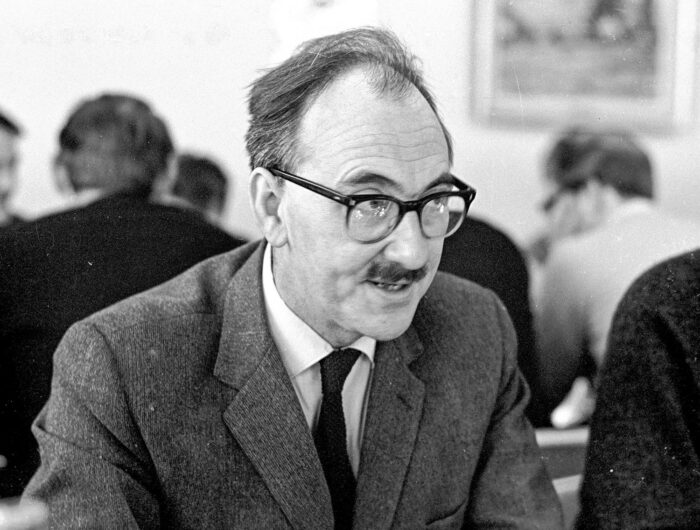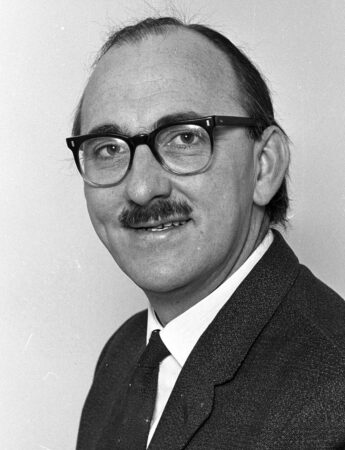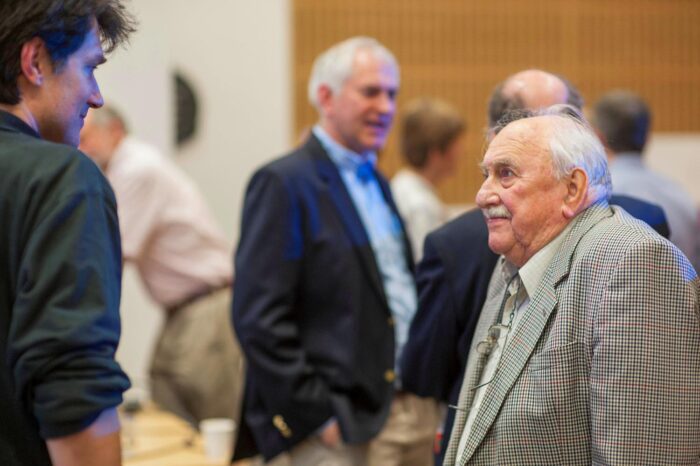
Brian Hartley, former Group Leader in the LMB’s PNAC Division and later Professor of Biochemistry at Imperial College London, died on Monday 3rd May 2021. Brian made outstanding contributions to protein chemistry, with his invention of new analytical methods, and produced for the first time an understanding of the properties of proteolytic enzymes on a structural basis. He later helped create the area of comparative evolutionary studies, developing genetic models for the evolutionary history of enzyme families to produce ancestor trees.
Brian was born on 16th April 1926 in Rawtenstall, Lancashire. He was educated at Bacup and Rawtenstall Grammar School, and then Queens’ College, Cambridge. He graduated in organic chemistry in 1947. The next two years he spent doing military service in the Navy, and was stationed at the Fleet Air Arm Station, Malta, as a Meteorological Officer. In 1949, he joined Bernard Kilby’s group in the Biochemistry Department at the University of Leeds and was awarded his PhD on ‘The mechanism of action of chymotrypsin’ in 1952.
For postdoctoral studies, Brian returned to Cambridge, to Malcolm Dixon’s enzyme unit in the University’s Department of Biochemistry. Malcolm was interested in the kinetics of the ‘nitrophenol burst’ that Brian had discovered during his PhD work when reacting chymotrypsin with nitrophenyl acetate. With Vince Massey, Brain started work using the fluorescent dye label, dansyl chloride, on chymotrypsin and chymotrypsinogen to see if there was a difference in conformation. The dye reacted quickly with the active centre of chymotrypsin, giving a green fluorescence, but only slowly produced a yellow fluorescence, typical of that given by labelled amino groups, with chymotrypsinogen. The dansyl chymotrypsin also gradually changed from red to green, indicating the migration from an adjacent histidine to the active site serine. The ‘dansyl’ method allowed the stepwise degradation and sequence determination of peptides on a micro scale and was widely used in many laboratories. At this point, Brian fell in love with protein chemistry, and decided he wanted to determine the complete amino acid sequence of chymotrypsin. It took 15 years to complete this.
With Fred Sanger in the department, Brian was able to learn the technique of end-group labelling with fluorodinitrobenzene from him. He also worked with Fred’s student, Mike Naughton, to label the active sites of trypsin, chymotrypsin, elastase and subtilisin with 32P-di-isopropylfluorophosphate (DFP) and do partial acid hydrolysis. The results showed that the active sites of trypsin and chymotrypsin were identical, whereas subtilisin was quite different. At this time, 1958, Fred’s group was considering an alliance with Max Perutz’s Medical Research Council Unit for the Study of the Molecular Structure of Biological Systems, to create a Laboratory of Molecular Biology. Brian had already been in contact with the MRC Unit, after discovering enormous crystals when doing ammonium sulphate precipitation of di-isopropylphosphoryl (DIP) -chymotrypsin. Max introduced Brian to David Blow, who had begun his work on determining the structure of chymotrypsin. This was the beginning of a lifelong collaboration between the two.
At about the same time, Brian took up a two-year Whitney Fellowship with Hans Neurath, in Seattle USA. There he worked on ion-exchange methods for peptide and protein purification, which had been developed by his friend Herb Sober. Before leaving Cambridge, Fred had offered Brian a post in his group when he returned to England, and so in 1960 when he came back to Cambridge, Brian found himself spending his time liaising with the MRC Unit and in designing the LMB. He helped design the fume cupboards and with Michael Fuller designed the arrangement of the third-floor laboratories, into which Fred’s group moved in early 1962.

Now at the LMB, Brian became a Group Leader in the Protein Chemistry (later PNAC) Division, of which Fred was the Head of Division. Brian continued his work on the sequence of proteins, making several major scientific contributions and inventing new methods in analytical protein chemistry. Following on from the ‘dansyl’ method, that he had initiated earlier, Brian developed the ‘diagonal’ method for locating covalent disulphide bridges of cystine residues in protein molecules and determining the amino acid sequence on either side. An enzymic digest of a protein is subjected to paper ionophoresis in one dimension: the products are then oxidised with performic acid on the paper and rerun at right angles using the same ionophoresis conditions. Peptides not containing cystine are unchanged and lie on a diagonal, whereas those having cystine are oxidised to give cysteic acid peptides which lie off the diagonal. The method can be used to determine the distribution of disulphide bridges, and also as a simple means of getting out a few special peptides in a pure form. A great deal of preliminary information about a protein may be obtained by this ‘diagonal’ method. In 1972, Max Perutz wrote: “Without Hartley’s ‘diagonal’ method the recent advances in determining the chemical constitution of immunoglobulins would hardly have been possible” (Letter from Max Perutz to P. T. Matthews, 25th April 1972. Biographical File, LMB Archive).
Brian published the complete sequence of chymotrypsinogen-A in 1964, a record at the time, as no protein of comparable size had yet been sequenced. This work enabled David Blow to complete the three-dimensional structure of chymotrypsin, and Brian and David collaborated to see if chymotrypsin’s catalytic function and its activation from an inactive precursor could be interpreted on the basis of its sequence and structure. This work was successful and led them to the formulation of two novel concepts in protein chemistry: internal salt bridges whose free energy of stabilisation is largely entropic, and charge transfer systems which turn chemically inert groups such as aliphatic hydroxyls into strong nucleophiles. Once the chymotrypsin problem was solved the varying specificities of the related enzymes trypsin, elastase and thrombin immediately fell into place and could be interpreted on a stereochemical basis.
After this, Brian’s interest moved from enzyme function to comparative evolutionary studies, an area he helped create. He gathered evidence indicating that enzymes like chymotrypsin, trypsin and elastase which showed a common catalytic mechanism, but differed in their substrate specificity, nevertheless presented a very similar sequence. From here, he proceeded to develop genetic models to account for the evolutionary history of enzyme families and to produce ancestor trees. This included showing that mammalian serine proteases, including the blood clotting cascade, had the same structures and mechanisms, indicating a common evolutionary origin.
Brian left the LMB in 1974, to become Head of Biochemistry at Imperial College London, developing it into a centre for molecular biology. His group continued to develop techniques for experimental enzyme evolution. In 1982, seeing the need to exploit breakthroughs in molecular biology, he set up the Imperial Centre for Biotechnology and became its first Director. He was a founding board member of Biogen, the genetic engineering company, and founded several other similar companies.
Brian was also a champion of young researchers and students. His group at the LMB hosted many postdoctoral students, several from America and elsewhere. He was a Fellow of Trinity College from 1964 and as Director of Studies he organised seminars for undergraduates interested in biochemistry and encouraged them to present papers themselves. He also lectured to the Part II biochemistry class. At Imperial, he enabled the Department to teach undergraduates for the first time. He supervised many successful PhD students, including Peter Rigby, Alan Weeds, Michael Neuberger and the future Nobel laureate, Greg Winter. Michael and Greg both later became Group Leaders, Heads of Division and Deputy Heads of the LMB.

Brian enjoyed scientific arguments and discussions, and would happily talk about the research problems of his own group and others, and he readily shared his wide knowledge of protein chemistry and enzymology. He showed great ingenuity, hard work and was stimulating company. He was one of the leaders whose work made the LMB successful. He remained a keen supporter of the LMB, attending many different events and reunions, including the 2014 Alumni Symposium.
He was elected to EMBO in 1971, and in the same year became a Fellow of The Royal Society, ‘for his studies on the structure and mode of action of the proteolytic enzymes.’
Greg Winter recollects: “Brian had a great influence on my early development as a scientist, and certainly his enthusiasm for evolving protein molecules rubbed off on me and others, including Michael Neuberger. I remember my time as Brian’s PhD student with great affection, although he was a somewhat daunting figure. He fizzed with ideas, and would gesticulate ferociously with his pipe, expounding his latest brainwave, or arguing science with César Milstein in the corridor. I also feared being shut up with Brian and pipe in his small office to go over my results, and being thoroughly fumigated all morning. Fortunately, these events were rare, as Brian expected his students to sort things out for themselves, but if needed, he would offer the burst of intellectual energy, enthusiasm and criticism needed to get things back on track. His pithy advice ranged from the best problems to tackle (“bugger interesting, lad, is it important?”) to the thoroughness expected in science (“it suggests isn’t good enough, dear boy, put a bloody stake through its heart”). He advised me to get on with experiments and not waste time reading the latest papers, as “if it’s really important, someone will tell you”.